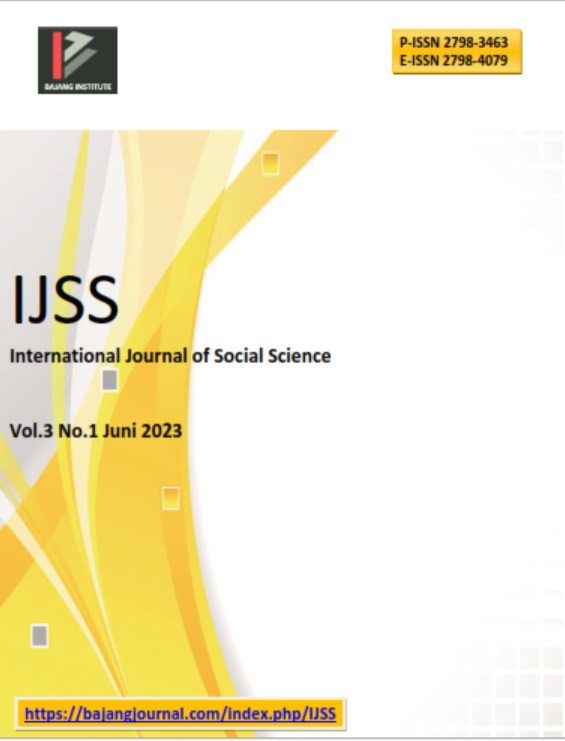ANALYSIS OF POTENTIAL CONFLICT AND PEACEFUL SOLUTIONS AS IMPACT OF STRATEGIC ENVIRONMENTAL DEVELOPMENTS AND ITS IMPLICATIONS ON NATIONAL SECURITY
DOI:
https://doi.org/10.53625/ijss.v3i1.6069Keywords:
Potential, Conflict, Peace, Strategic Environment, SecurityAbstract
Developments in the strategic environment can create both opportunities and threats for Indonesia which must be addressed with a national defense system that is able to take advantage of Indonesia's opportunities and advantages to maximize the achievement of Indonesia's strategic interests and counteract all threats to Indonesia's national security arising from the dynamics of developments in the strategic environment. This study aims to analyze the potential for conflict as a result of developments in the strategic environment. This research was conducted with a qualitative descriptive approach. The results of the study indicate that the potential for open conflict escalation in the region is very likely to arise if a misperception or incident occurs at the locus of dispute. The biggest possibility of an open conflict is a battle in maritime theater that occurs in the South China Sea and East China Sea between the US and its allied countries in the Indo-Pacific region and China, or between China and one or more countries that have territorial disputes with China. . Indonesia's geographical position which is at the crossroads of the Pacific and Indian Oceans as well as the continents of Asia and Australia makes Indonesia very vulnerable to spill impacts arising from all conflicts that occur in the Indo-Pacific region.
References
Susmoro, H., Nugroho, Haris D. & Handwiono, Y. (2019). Bunga Rampai Penetapan Batas Maritim RI–Negara Tetangga (Peran Pushidrosal dalam Mendukung Diplomasi Maritim Indonesia). Jakarta: Pusat Hidrografi dan Oseanografi TNI-AL.
Jervis, R. (1997). System Effects: Complexity in Political and Social Life. New Jersey: Princeton University Press.
U.S. Department of Defense (2013). A Taxonomy of Operational Cyber Security Risks.
Hanlon, Michael O’. (2018). Forecasting Change in Military Technology, 2020-2040. Washington DC: The Brookings Institution.
Meyer, Patrick K. et al. (2019). Indonesia’s swift securitization of the Natuna Islands: How Jakarta countered China’s claims in the South China Sea, Asian Journal of Political Science, 27 (1), 1-18.
Badan Perencanaan Pembangunan Nasional Republik Indonesia (2019). Rancangan Teknokratik Rencana Pembangunan Jangka Menengah Nasional 2020-2024.
Adnyana, Putu J. (2017). Sinergitas TNI Angkatan Laut dalam Pemberdayaan Wilayah Pertahanan Laut Melalui Peningkatan Kesadaran Bela Negara (Studi di Kelurahan Tanjung Sengkuang Pulau Batam), Jurnal Prodi Strategi Perang Semesta, 3 (1), 59-74.
Moleong, L.J. (2002). Qualitative Research Methodology. Bandung: Youth Rosda Karya.
Bungin, B. (2009). Penelitian Kualitatif. Jakarta: Kencana Prenada Media Group.
Chairani, A. Zahra. (2019). Papua Conflict: Conflict Transformation? Kompasiana.com., December 2019.
Acharya, A. (1995). ASEAN and Asia-Pacific Multilateralism: Managing Regional Security. Dalam Amitav Acharya & Richard Stubbs (ed.), New Challenges for ASEAN: Emerging Policy Issues (hlm. 182-202). Vancouver: University of British Columbia Press.
Supriyatno, M. (2014). Tentang Ilmu Pertahanan. Jakarta: Yayasan Pustaka Obor Indonesia.
Yarger, Harry R. (2006). Strategic Theory for the 21st Century: The Little Book on Big Strategy. Pennsylvania: The Strategic Studies Institute.
Magee II, Roderick R. (1998). Strategic Leadership Primer. Pennsylvania:U.S. Army War College.
Gray, Colin S. (1999). Modern Strategy. Oxford: Oxford University Press.
Lykke Jr., Arthur F. (1989). Defining Military Strategy, Military Review, 69(5), 2-8.
Hikam, Muhammad A. S. (2014). Menyongsong 2014-2019: Memperkuat Indonesia dalam Dunia yang Berubah. Jakarta: CV. Rumah Buku.
Institute of International and Strategic Studies (2020). Military Balance 2020. London: Routledge.
Trump, Donald J. (2017). The 2017 National Security Strategy of the United States. Washington DC: White House.
Institute of International and Strategic Studies (2020). Military Balance 2020. London: Routledge.
U.S. Department of Defense (2020). Military and Security Developments Involving the People’s Republic of China 2020: Annual Report to Congress.
Herzinger, B. (2020). Learning in the South China Sea: The U.S. Response to the West Capella Standoff. Diakses pada tanggal 9 Oktober 2020 dari https://warontherocks.com/2020/05/learning-in-the-south-china-sea-the-u-s-response-to-the-west-capella-standoff/
Downloads
Published
How to Cite
Issue
Section
License
Copyright (c) 2023 Arifuddin Uksan

This work is licensed under a Creative Commons Attribution 4.0 International License.

















